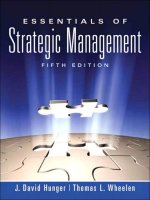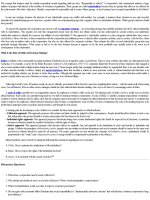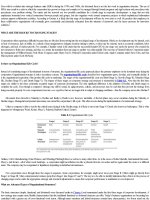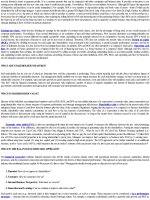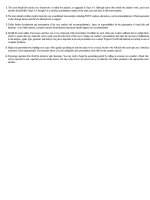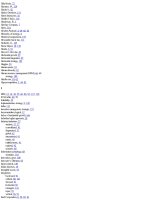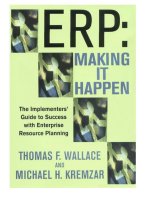Essentials of Strategic Management The Quest for Competitive Advantage_2 pdf
Bạn đang xem bản rút gọn của tài liệu. Xem và tải ngay bản đầy đủ của tài liệu tại đây (319.07 KB, 26 trang )
ERP
AS A
F
OUNDATION
Today, there are a wide variety of tools and techniques that have been
designed to help companies and their people produce their products
better and more efficiently. These include Lean Manufacturing, Six
Sigma Quality, Employee Involvement, Factory Automation, De-
sign for Manufacturability, and many more. These are excellent tools
with enormous potential.
But none of them will ever yield their full potential unless
they’re coupled with effective forecasting, planning, and scheduling
processes. Here’s why:
It’s not good enough to be extremely efficient if you’re making
the wrong stuff.
It’s not good enough to make items at a very high level of quality
if they’re not the ones needed.
It’s not good enough to reduce setup times and cut lot sizes if bad
schedules prevent knowing what’s really needed and when.
Back in the early 1980s, a new way of thinking about manufactur-
ing came out of Japan, and it was truly revolutionary. In this country
we’ve called it Just-In-Time (JIT), and more recently it has evolved
into Lean Manufacturing.
1
As with most new tools and processes, its early adherents pro-
moted JIT with a missionary zeal—and rightly so. This is great stuff.
Some of them, however, took the approach that MRP/MRP II was
no longer necessary for companies doing JIT. The MRP establish-
ment pushed back and the result was a raging debate that generated
a lot of heat and not much light.
Today we can see the situation much more clearly, and we feel this
view has been best articulated by Chris Gray, president of Gray Re-
search in Wakefield, NH. Chris says that improvements to business
processes take one of three forms:
1. Improving process reliability. Six Sigma and other Total Qual-
ity tools are predominant here.
14 ERP: M I H
1
Also called Agile Manufacturing or Synchronous Flow Manufacturing.
2. Reducing process complexity. Lean Manufacturing is heavily
used here.
3. Coordinating the individual elements of the overall set of
business processes. ERP lives here.
Enterprise Resource Planning, when operating at a high level of
effectiveness, will do several things for a company. First, it will enable
the company’s people to generate enormous benefits. Many compa-
nies have experienced, as a direct result of ERP (or MRP II) dra-
matic increases in responsiveness, productivity, on-time shipments
and sales, along with substantial decreases in lead times, purchase
costs, quality problems, and inventories.
Further, ERP can provide the foundation upon which additional
productivity and quality enhancements can be built—an environment
where these other tools and techniques can reach their full potential.
Effective forecasting, planning and scheduling—knowing rou-
tinely what is needed and when via the formal system—is funda-
mental to productivity. ERP is the vehicle for getting valid plans and
schedules, but not just of materials and production. It also means
valid schedules of shipments to customers, of personnel and equip-
ment requirements, of required product development resources, and
of cash flow and profit. Enterprise Resource Planning has proven it-
self to be the foundation, the bedrock, for supply chain management.
It’s the glue that helps bind the company together with its customers,
distributors, and suppliers—all on a coordinated, cooperative basis.
M
ORE ABOUT
S
OFTWARE
Now that we’ve kicked the ERP topic around a bit, let’s double back
on the software issue. Software for ERP is like a set of golf clubs. You
could give the greatest, most expensive set of golf clubs ever made to
either one of your friendly authors, but they wouldn’t break 120.
Why? It’s simple; neither of us knows how to play golf.
On the other hand, let’s say we send Tiger Woods out on the pro
tour with only a four-wood and a sand wedge. Would Tiger win any
tournaments? Not a chance. He’d never even make the cut. The rea-
son: To be competitive at the highest levels of the game, you need a
full set of clubs in the bag.
Enterprise Resource Planning 15
Two principles flow from this analogy:
1. The acquisition of the tools, of and by itself, will not make you
proficient in their use and thus will not provide a competitive
advantage.
2. To be truly competitive, you need a good and reasonably com-
plete set of tools.
Too many companies have bought an extremely expensive set of
“golf clubs” (an enterprise software system) but haven’t learned how
to play golf. That’s why we read about so many “ERP failures” in the
business press. The fact of the matter is that ERP hasn’t failed at all
in those cases; it hasn’t even been attempted. Saying that ERP failed
in these cases is like saying that golf failed because one of your au-
thors bought a $2,000 set of golf clubs and didn’t break 120. Golf
failed? Makes no sense.
T
HE
ABC
SOF
I
MPLEMENTATION
Let’s look at the ABCs of implementing Enterprise Resource Plan-
ning. The concept is derived from the basic ABC approach to inven-
tory control, in turn derived from Pareto’s law. In that technique, the
A items are considered very significant, costly, important, etc.
Hence, they deserve the most attention and the most careful plan-
ning and control. The B items are of less significance than the A
items, and, hence, less time is devoted to each of them. The C items,
while essential, are of least overall significance and are given pro-
portionate attention.
This ABC approach, applied to implementation, states that Item
C is the computer, both the hardware and software. It’s essential since
ERP can’t be done manually, but it’s of lesser significance overall
than the other elements.
Item B is the data: the inventory records, the bills of material, the
routings, etc. They are more significant and require more of the com-
pany’s overall attention and managerial emphasis.
Item A is the people, the most important element in making it hap-
pen. If the people part of the implementation process is managed
properly, the people will understand the objectives and how to get
16 ERP: M I H
there. They’ll take care of getting and keeping the data accurate.
They won’t allow the “computer tail” to wag the “company dog,” as
has been the case far too often. People are the key.
C
LASS
ABCD
At the risk of getting into what might look like alphabet soup, we
need to introduce another concept based on the letters A, B, and C
plus one more. Here goes.
By the mid-1970s the term MRP had become a buzzword. Almost
everyone, it seemed, was “doing MRP.” Many companies weren’t
happy with their results. On the other hand, some companies were
achieving spectacular results. Companies’ reactions to MRP ranged
from: “It hasn’t helped us at all.” to “It’s terrific; we couldn’t run the
business without it.”
It became obvious that there were profound differences in how
well companies were using this set of tools. To help focus on this is-
sue, Oliver Wight, the leading pioneer in this field, developed the
ABCD classification. (See Figure 1-6.)
Class D installations have often been viewed as “another com-
puter failure.” This strikes us as a bum rap for the computer, because
the computer is the only element that’s doing its job. Has the com-
puter failed? No, it’s working. Has ERP failed? Not really; it hasn’t
Figure 1-6
Class A Effectively used company-wide; gener-
ating significant improvements in cus-
tomer service, productivity, and costs.
Class B Supported by top management; used by
middle management to achieve measur-
able quality improvements.
Class C Operated primarily as better methods
for ordering materials; contributing to
better inventory management.
Class D Information inaccurate and poorly un-
derstood by users; providing little help
in running the business.
Enterprise Resource Planning 17
had a chance. What has failed? The people in the company. They’ve
failed to implement and operate this set of tools successfully.
Class C means a company has reduced its inventories, in some
cases substantially, and probably is better able to manage engineer-
ing changes. The return on investment (ROI) for Class C typically is
very good. However, the company really hasn’t changed the way it
runs the business.
The company operating ERP at a Class B level has dramatically
improved its ability to deliver the product on time to its customers,
minimize shortages in the plant, avoid unplanned overtime, reduce
inventories, and cope with the myriad of changes that typically con-
front a manufacturing organization.
Class A yields all of the Class B benefits and more. The business is
managed with one consistent set of numbers, from top manage-
ment’s sales & operations plans down through the detailed schedules
for the plant floor, the suppliers, the distribution centers and, most
important, the customers. Financial plans and reports are developed
from the highly accurate operational numbers used to run the busi-
ness on a day-to-day basis. Extensive use is made of simulation, per-
forming what-if analyses using the ERP data base, in both units and
dollars.
To evaluate their performance, many companies have used the
Oliver Wight ABCD Checklist for Operational Excellence (Fifth edi-
tion, 2000, John Wiley & Sons, New York, NY). This checklist is a
series of questions which an organization can self-administer to de-
termine how effectively it’s using the tools of ERP, and this process
results in a letter grade (A,B, C, or D) and helps to determine the
path for improvement.
I
MPLEMENTERS AND
R
E
-I
MPLEMENTERS
This book deals with how to implement ERP at a Class A level.
Further, it applies to both first-time implementers and to re-
implementers, companies whose first implementation resulted in
Class C or D results and who now want to get the full bang for their
buck. For those of you who’ll be re-implementing, be of good cheer:
Many companies now getting Class A results got there via re-
implementation. The steps involved in a re-implementation are vir-
tually identical to a first-time implementation; the main difference is
18 ERP: M I H
TEAMFLY
Team-Fly
®
that some of the necessary steps may have already been accom-
plished satisfactorily.
Many companies today need to re-implement. Some of these are
companies who, as we saw earlier, thought they were implement-
ing ERP, but actually were only installing enterprise software. Their
motivations were largely software-driven: Y2K compliance, legacy
systems becoming unworkable, multiple hardware platforms sup-
porting too many operational systems, etc. The problem is that, in
many cases, the new software was installed but not much else
changed.
Many companies’ ERP implementations in the past started out
with the best intentions in the world. Company S, for example,
wanted to re-engineer and improve processes, to improve the way
they managed the business, and to give far better customer service to
an increasingly demanding customer base. During the implementa-
tion, however, they were overwhelmed by the software. Enterprise
software tends to be highly complex, and complexity can make it
very difficult to install. As the implementation project took longer
and longer, and cost more and more, top management became more
and more impatient. The result: a decision to forget about imple-
menting better business processes and just get the software running.
Thus, Company S has new software but is still running the busi-
ness in much the same old way, and thus they need to re-implement.
2
If you’re in this category, this book is intended for you every bit as
much as for the company implementing for the first time.
T
HE
I
MPLEMENTERS
’D
ILEMMA
In the chapters to come, we’ll talk a lot about the “Proven Path,”
which is the implementation approach we recommend. The com-
pany that follows the Proven Path can be virtually assured of a suc-
cessful implementation. The dilemma is that some companies may
not be able to follow the Proven Path, and the reason has to do with
software.
Let’s look at the three types of companies wanting to implement
enterprise resource planning:
Enterprise Resource Planning 19
2
Some call this a “second wave” implementation.
The first type of company has already installed enterprise software.
Now it wants to improve its business processes by implementing
ERP, and thus capitalizing on the ES investment. The Proven Path
will work very nicely for this company, probably in the Quick Slice
variant discussed in Chapters 13 and 14.
The second category of company has not yet installed a complete set
of enterprise software (although it may have installed a few mod-
ules of an ES). ERP is a higher priority than ES; thus software is-
sues will be subordinated to the ERP initiative. This company has
what we call a “clean sheet of paper” and the Proven Path applies
completely.
In the third case, the company has already begun installing enter-
prise software or is about to do so. ES is the priority. This company
may not be able to simultaneously implement ERP using the
Proven Path. Here’s the dilemma: workload. Installing enterprise
software can be an enormous task. Even with lots of people from
outside consulting firms, the time requirements for the company’s
people are very large.
Later we’ll discuss in detail why implementing ERP cannot be sub-
contracted to outsiders. For now, take it on faith: An ERP imple-
mentation is a do-it-yourself project; it requires intimate knowledge
of your business. The essence of implementing ERP is to acquire bet-
ter business processes, and these must be implemented by the people
operating the business.
That said, if these folks are pretty much overwhelmed with a) do-
ing their day-to-day jobs and b) participating heavily in an ES in-
stallation, they won’t have the time or mental energy necessary to do
the hard work involved in implementing ERP. Thus this company
will not be able to follow the Proven Path. They may pay it lip service.
They may pretend they’re following it. But they can’t. They don’t
have the horses.
We call these companies “dilemma companies” and our advice to
them is simple: Don’t try to implement ERP simultaneously with in-
stalling an enterprise software system if you aren’t convinced that
your people have the time to do it justice. Rather, we recommend that
you:
20 ERP: M I H
• recognize the dilemma,
• complete the ES installation,
• start to make a limited number of process improvements during
the ES installation, ones that won’t consume large amounts of
peoples’ time. (One excellent process that applies here is Sales &
Operations Planning, covered in Chapter 8. Another opportu-
nity is data integrity, discussed in Chapter 10.) As you make
these improvements, recognize that you are not following the
Proven Path, but rather that you are doing things that are con-
sistent with it and that will make the task easier when you begin
an ERP implementation.
Then, following the ES installation, you will have ceased being a
dilemma company and have migrated to the Type 1 company previ-
ously identified. You have implemented ES software, and are now in
a position to initiate a Proven Path implementation of ERP. Bob
Stahl, a highly successful ERP consultant based in Attleboro, MA,
says it well:
The Proven Path was sound 15 years ago, before the onset of en-
terprise software. It’s every bit as sound today. However, given to-
day’s very complex, hard-to-install software, it’s more important
than ever to follow the Proven Path correctly and with the right
timing.
Coming up in the next chapter: a closer look at the Proven Path.
Enterprise Resource Planning 21
N
OTES
i
Mission Critical—Realizing the Promise of Enterprise Systems, 2000,
Harvard Business School Press, Boston, MA.
ii
ERP—Tools, Techniques, and Applications for Integrating the Supply
Chain, 1999, St.Lucie Press/APICS, Falls Church, VA.
iii
APICS Dictionary, Ninth Edition, 1998, APICS—The Educational
Society for Resource Management, Falls Church, VA.
22 ERP: M I H
Q & A
WITH THE
A
UTHORS
T
OM
: Mike, you were one of the key players at Procter & Gam-
ble’s very successful implementations of ERP (which I think you
called MRP II). When you got started with MRP II, had P&G al-
ready implemented enterprise software, or were you a “clean
sheet of paper company,” or were you in the dilemma category
of having just too much on your plates for a Proven Path imple-
mentation?
M
IKE
: We were all of these. SAP (our enterprise software pack-
age) in Europe was 80 percent installed before MRP II got started.
In North America, we started with business process improve-
ments, one being Sales & Operations Planning, and the SAP in-
stallation came a bit later. Latin America was pretty much a clean
sheet of paper. On the other hand, Asia was certified as Class A
before we ever heard of SAP or other enterprise software pack-
ages.
One last point: Our selection of SAP as the software supplier
was influenced somewhat by the fact that an older version of it (R-
2) was almost totally installed in Europe. We might have been
happy with a number of other software packages, but our Euro-
pean folks had been working with SAP for some time and were
comfortable with them. We felt it was important not to require
them to change unless there was a compelling reason to do so.
Chapter 2
The Implementation
Challenge
C
ATCH
-22
There’s an apparent catch-22 involved in implementing Enterprise
Resource Planning successfully. It goes like this:
1. It’s a lot of work.
Implementing ERP as a new set of decision-making processes is a
major undertaking involving many people throughout the company,
including general management. In essence, the entire company must
learn how to deal with demand and supply issues in a new way. The
speed of information flow with enterprise software combined with
ERP’s new approach to all of the planning and execution systems
represents a major shift in company thinking—and that means a lot
of work.
2. It’s a do-it-yourself project.
Successful implementations are done internally. In other words, vir-
tually all of the work involved must be done by the company’s own
people. The responsibility can’t be turned over to outsiders, such as
consultants or software suppliers. That’s been tried repeatedly, and
23
hasn’t worked well at all. Consultants can have a real role in provid-
ing expertise but only company people know the company well
enough and have the authority to change how things are done.
When implementation responsibility is de-coupled from opera-
tional responsibility, who can be legitimately accountable for results?
If results aren’t forthcoming, the implementers can claim the users
aren’t operating it properly, while the users can say that it wasn’t im-
plemented correctly. Almost without exception, the companies who
have become Class A or B and have achieved the greatest bottom-
line benefits are the ones where the users implemented ERP them-
selves.
Therefore, a key principle of implementation is:
IMPLEMENTERS = USERS
The people who implement the various tools within Enterprise Re-
source Planning need to be the same folks who will operate those
tools after they’re implemented.
3. It’s not priority number one.
The problem is, the people who need to do it are already very busy
with their first priority: getting customer orders, making shipments,
meeting payroll, keeping the equipment operating, running the busi-
ness. All other activities must be subordinate. Implementing ERP
can’t be priority number one, but it does need to be pegged as a high
priority within the company, preferably the number two priority,
right below running the business.
Well, who runs the business? People do. People starting with gen-
eral managers
1
as well as department leaders in sales, manufacturing,
finance, and marketing. Virtually everyone in the company has a
stake, including those who plan, produce, and sell the product at
every level in the business.
24 ERP: M I H
1
Throughout this book, we’ll use the term General Manager to refer to the sen-
ior executive in charge of the business unit. In this context, general manager can be
synonymous with President, Chief Executive Officer, or Managing Director. It is the
person to whom all the major disciplines report: Sales & Marketing, Operations,
Product Development, Finance.
This catch-22 is one of the reasons why many companies that im-
plement ERP never get beyond Class C. Other reasons include:
It’s people-intensive.
ERP is commonly misperceived as a computer system. Not so. It’s a
people system made possible by the computer software and hard-
ware.
It requires top management leadership and participation.
If the goal is truly to run the business better, then the general man-
ager and staff must be deeply involved because they and they alone
have the real leverage over how the business is to be managed.
Changes made at a lower level in the organization won’t matter much
if it’s business as usual at the top. Bob Stahl says: “I find that prior-
ity comes from a leadership who understands that ERP is tied to
their future success. It becomes part of their defined ‘strategic im-
peratives.’”
It involves virtually every department within the company.
It’s not enough for just the manufacturing or logistics or materials
departments to be on board. Virtually all departments in the com-
pany must be deeply involved in implementing ERP; those men-
tioned, plus marketing, engineering, sales, finance, and human
resources.
It requires people to do their jobs differently.
Most companies implementing ERP must undergo massive behav-
ior change to be successful. ERP requires a new set of values. Many
things must be done differently, and this kind of transformation is
never easy to achieve.
Many people in general management will assume that a massive
software change such as an ES is sufficient to achieve major results.
In fact, this system simply moves more information faster and
deeper in the company. If the actual work processes don’t change,
then bad information moves more quickly and with dangerous mo-
The Implementation Challenge 25
mentum across the company. ERP provides the work and people
process to make sense out of this rapid flow of data.
Experienced users say implementing ERP is more difficult than
building a new plant, introducing a new product, or entering a whole
new market. Breaking through the catch-22, overcoming the people
problems, making it happen—these are the challenges.
That’s the bad news.
The good news is there’s a way to meet these challenges. There’s no
mystery involved. Implementing ERP successfully can be almost a
sure thing—if it’s done right. Yes, it is a lot of work. However, ERP
has never failed to work, not once, when correctly implemented. It
will work and users will realize enormous benefits.
Doing it right involves two major elements:
1. An aggressive implementation schedule, focused on achieving
maximum benefits in minimum time.
2. The Proven Path. A set of steps that, if followed, will ensure a
successful implementation.
A
N
A
GGRESSIVE
I
MPLEMENTATION
S
CHEDULE
The question arises: “How long should it take to implement all of the
functions of Enterprise Resource Planning throughout the entire
company, from when we start until we’re fully implemented?” First of
all, it’s difficult to implement all of ERP, company wide, in less than
a year. Some companies have achieved Class A status in less than 12
months, but not many. Why? Simply because so many things need to
be done: massive education, data integrity, changing the way the busi-
ness is run. And, all the while, it’s not the number one priority.
On the other hand, for an average-sized or smaller company (divi-
sion, business unit), if it’s taking longer than two years, it’s probably
not being done correctly. As a matter of fact, if a given business unit
takes longer than two years to implement, the odds for achieving su-
perior results decrease sharply. It becomes more and more difficult
to maintain the intensity, the enthusiasm, the drive and dedication
26 ERP: M I H
necessary, and thus it’s harder to keep ERP pegged as a very high pri-
ority. The world is simply changing too fast.
Therefore, plan on the full implementation of Enterprise Resource
Planning for a given business unit to take longer than one year, but
less than two. For purposes of simplicity and consistency, let’s rou-
tinely refer to an 18-month implementation. Now 18 months is a
fairly long time. Therefore, during that period, early successes are
important, and thus we recommend that they be identified and ag-
gressively pursued. The most important early win is typically Sales &
Operations Planning (to be covered in Chapter 8), and another is in-
ventory record accuracy (Chapter 10).
On the other hand, some people feel an 18-month time frame is
too aggressive or ambitious. It’s not. It’s a very practical matter, and
also necessary. Here’s why:
Intensity and enthusiasm.
Because ERP will be implemented by the people running the busi-
ness, their first priority must be running the business, which is a full-
time job in itself. Now their responsibilities for implementing ERP
will require more work and more hours above and beyond running
the business.
With a long, extended project, these people will inevitably become
discouraged. The payoff is too far in the future. There’s no light at the
end of the tunnel.
However, with an aggressive schedule, these people can see
progress being made early on. They can expect improvement within
a relatively short time. In our experience, the operating people—
sales and marketing people, foremen, buyers, engineers, planners,
etc.—respond favorably to tangible gains.
Priority.
It’s quite unlikely ERP can hold the necessary high priority over
three or four years. (Companies are like people; their attention spans
are limited.) As the project’s priority drops, so do the odds for suc-
cess. The best approach is to establish ERP as a very high priority;
implement it quickly and successfully. And then capitalize on it.
Build on it. Use it to help run the business better and better.
The Implementation Challenge 27
Unplanned change.
Unforeseen changes come in two forms: changes in people and
changes in operating environment. Each type represents a threat to
the ERP project.
Regarding people changes, take the case of a division whose gen-
eral manager is ERP-knowledgeable, enthusiastic, and leading the
implementation effort. Suppose this person is suddenly promoted to
the corporate office. The new general manager is an unknown entity.
That person’s reaction to ERP will have a major impact on the pro-
ject’s chances for success. He or she may not be supportive of ERP
(usually because of a lack of understanding), and the entire imple-
mentation effort will be at risk.
Environmental change includes factors such as a sharp increase in
business (“We’re too busy to work on ERP”), a sharp decrease in
business (“We can’t afford ERP”), competitive pressures, new gov-
ernmental regulations, etc.
While such changes can certainly occur during a short project,
they’re much more likely to occur over a long, stretched-out time
period.
Schedule slippage.
In a major project like implementing ERP, it’s easy for schedules to
slip. If the enterprise software is being installed at the same time, soft-
ware installation deadlines might suggest pushing back the planning
portion of ERP. Throughout this book, we’ll discuss ways to mini-
mize slippage. For now, let us just point out an interesting phenom-
enon: In many cases, tight, aggressive schedules are actually less
likely to slip than loose, casual, non-aggressive schedules.
Benefits.
Taking longer than necessary to implement defers realizing the bene-
fits. The lost-opportunity cost of only a one-month delay can, for
many companies, exceed $100,000. A one-year delay could easily
range into the millions. An aggressive implementation schedule, there-
fore, is very desirable. But is it practical? Yes, almost always. To un-
derstand how, we need to understand the concept of the three knobs.
28 ERP: M I H
TEAMFLY
Team-Fly
®
The Three Knobs
In project management, there are three primary variables: the
amount of work to be done; the amount of time available (calendar
time, not person-years); and the amount of resources available to ac-
complish the work. Think of these as three knobs, which can be ad-
justed (as shown in Figure 2-1).
It’s possible to hold any two of these knobs constant by varying
the third. For example, let’s assume the following set of conditions:
1. The workload is considered to be a constant, a given. There is
a certain amount of work that simply has to be done to imple-
ment ERP.
2. The time can also be considered a constant, and, in this ex-
ample, let’s say it’s fixed at about 18 months.
3. The variable then becomes the resource knob. By adjusting it,
by providing resources at the appropriate level, the company
can accomplish the necessary amount of work in the defined
time. (Developing a proper cost-benefit analysis can put the
resource issue into clearer focus, and we’ll return to that issue
in Chapter 5.)
But, what if a company can’t increase the resource knob? Some-
times, it’s simply not possible. Maybe there’s not enough money, or
the organization is stretched so thin already that consuming large
blocks of employee time on an implementation just isn’t in the cards.
Well, there’s good news. Within the Proven Path, provisions are
made for:
The Implementation Challenge 29
WORK TIME
RESOURCES
Figure 2-1
Work, Time, and Resources
• Company-wide implementation: total company project; all
ERP functions implemented; time frame one to two years.
• Quick-Slice ERP implementation: confined to one or several
Pareto
2
high-impact product lines; most, but not all, ERP func-
tions implemented; time frame three to five months.
With Quick-Slice ERP, the resources are considered a constant,
because they are limited. Further, the time is considered fixed and
is a very short, aggressive period. Thus the variable becomes the
amount of work to be done. The principle of urgency applies here
also; since only a portion of the products/company will be cutting
over to ERP, it should be done quickly. This is because the company
will need to move aggressively to the next step, which may be to do
another Quick-Slice implementation on the next product family or
perhaps to convert to a company-wide implementation.
Resource constraints are only one reason why companies elect to
begin implementation on a Quick-Slice basis. For other reasons, and
for a detailed description of the Quick-Slice implementation process
via the Proven Path, see Chapters 13 and 14. For now, let’s examine
the Proven Path methodology, realizing that either implementation
approach—company-wide or Quick Slice—applies.
T
HE
P
ROVEN
P
ATH
Today there is a tested, proven way to implement Enterprise Re-
source Planning. Thirty or so years ago, no one could say that. Back
then, people said:
It should work.
We really believe it’ll work.
It stands a good chance of working.
It certainly ought to work.
30 ERP: M I H
2
Pareto’s law refers to the principle of the “vital few—trivial many.” For example,
in many companies, 30 to 60 percent of their sales comes from 5 to 10 percent of
their products. Pareto’s law is also the basis for ABC inventory analysis, and is used
extensively within Total Quality Management and Lean Manufacturing/Just-In-
Time.
No more. There’s no longer any mystery about how to implement
ERP. There is a well-defined set of steps, which guarantees a highly
successful implementation in a short time frame, if followed faith-
fully and with dedication.
3
These steps are called the Proven Path.
If you do it right, it will work. Period. And you can take that to the
bank.
How can we be so certain? How did this become such a sure thing?
The main reason centers on some executives and managers in certain
North American manufacturing companies. They had several things
in common: a dissatisfaction with the status quo, a belief that better
tools to manage their business could be developed, and an ample
supply of courage. These early implementers led the way.
Naturally, they had some help. Consultants and educators were
key to developing theory and practice. Computer companies, in the
early days, developed generalized software packages for material re-
quirements planning, capacity requirements planning, and plant
floor control. But, fundamentally, the users did it themselves.
Over the past 35 years, thousands of companies have implemented
MRP/MRPII/ERP. Many have implemented very successfully
(Class A or B); even more companies less so (Class C or D). By ob-
serving a great variety of these implementation attempts and their
results, it’s become very clear what works and what doesn’t. The
methods that have proven unworkable have been discarded. The
things that work have been refined, developed, and synthesized into
what we call the Proven Path. Today’s version of the Proven Path is
an evolutionary step over the prior ones; it has been refined for ERP
but it is true to the history of proven success over a quarter century.
The Proven Path isn’t theory; it’s not blue sky or something
dreamed up over a long weekend in Colorado Springs, where the air’s
really thin. Rather, it’s a product of the school of hard knocks—built
out of sweat, scar tissue, trial and error, learning, testing, refining.
Surprising? Not really. The Proven Path evolved the same way
ERP did—in a pragmatic, practical, and straightforward manner. It
wasn’t created in an ivory tower or a laboratory, but on the floors of
our factories, in our purchasing departments, in our sales and mar-
keting departments, and on our shipping docks.
The Implementation Challenge 31
3
Faithfully and with dedication are important words. They mean that this is not a
pick-and-choose kind of process. They mean skip no steps.
This evolution has continued, right into the twenty-first century,
triggered by three factors:
1. New opportunities for improvement.
2. Common goals and processes.
3. Time pressures to make improvements quickly.
Keep in mind, when the original Proven Path was developed by Dar-
ryl Landvater in the mid-1970s, what was then called closed-loop
MRP was close to being “the only game in town” for major im-
provements in manufacturing companies. Quality? In the United
States that was viewed as the job of the quality control department,
and people like W. Edwards Deming and others had to preach the
gospel of Total Quality Control in other parts of the world. Just-in-
Time, and its successor, Lean Manufacturing hadn’t yet hit the
North American continent in any meaningful way. Other important
tools like Design for Manufacturability, Activity-Based Costing, and
Gainsharing, hadn’t been invented yet or existed in small and rela-
tively unpublicized pockets of excellence.
Today, it’s a very different world. It is no longer good enough to
implement any one major initiative and then stop. Tools like Enter-
prise Resource Planning, Lean Manufacturing, Total Quality Man-
agement, and others are all essential. Each one alone is insufficient.
Companies must do them all, and do them very well, to be competi-
tive in the global marketplace of the 2000s. Winning companies will
find themselves constantly in implementation mode, first one initia-
tive, then another, then another. Change, improvement, implemen-
tation—these have become a way of life.
As competitive pressures have increased, so has the urgency to
make rapid improvement. Time frames are being compressed, nec-
essary not only for the introduction of new products, but also for new
processes to improve the way the business is run.
The current Proven Path reflects all three of the aforementioned
factors. It is broader and more flexible. It incorporates the learning
from the early years and includes new knowledge gleaned from ERP.
Further, it offers an option on timing. The original Proven Path dealt
with implementation on a company-wide basis only: all products, all
components, all departments, and all functions to be addressed in
32 ERP: M I H
one major implementation project. However, as we’ve just seen, the
current Proven Path also includes the Quick-Slice implementation
route,
4
which can enable a company to make major improvements in
a short time.
The Proven Path consists of a number of discrete steps that will be
covered one at a time. We’ll take a brief look at each of these steps
now, and discuss them more thoroughly in subsequent chapters. The
steps, shown graphically in Figure 2-2, are defined as follows:
• Audit/Assessment I.
An analysis of the company’s current situation, problems, opportu-
nities, strategies, etc. It addresses questions such as: Is Enterprise
Resource Planning the best step to take now to make us more com-
petitive? If so, what is the best way to implement: company-wide or
Quick-Slice? The analysis will serve as the basis for putting together
a short-term action plan to bridge the time period until the detailed
project schedule is developed.
• First-cut Education.
A group of executives and operating managers from within the com-
pany must learn, in general terms, how Enterprise Resource Plan-
ning works; what it consists of; how it operates; and what is required
to implement and use it properly. This is necessary to affirm the di-
rection set by audit/assessment I and to effectively prepare the vision
statement and cost/benefit analysis. It’s essential for another reason:
These leaders need to learn their roles in the process, because all sig-
nificant change begins with leadership.
A word about sequence: Can first-cut education legitimately occur
before audit/assessment I? Indeed it can. Should it? Possibly, in those
cases where the executive team is already in “receive mode,” in other
words, ready to listen. Frequently, however, those folks are still in
“transmit mode,” not ready to listen, and audit/assessment I can help
them to work through that. Further, the information gained in au-
dit/assessment I can be used to tailor the first-cut education to be
more meaningful and more relevant to the company’s problems.
The Implementation Challenge 33
4
Quick-Slice ERP will be covered later in this book.
INITIAL EDUCATION AND TRAINING
SALES & OPERATIONS PLANNING
DEMAND MANAGEMENT, PLANNING, AND SCHEDULING PR
OCESSES
PROCESS DEFINITION
FINANCE & ACCOUNTING PROCESSES
PROCESS DEFINITION AND IMPLEMENT
ATION
SOFTWARE CONFIGURATION & INSTALLA
TION
PILOT AND CUTOVER
SOFTWARE SELECTION
PERFORM-
ANCE
GOALS
PROJECT
ORGANIZ-
ATION
AUDIT/
ASSESSMENT III
ONGOING EDUCATION
AND TRAINING
ADDITIONAL
INITIATIVES
BASED ON
CORPORATE
STRATEGY
ONGOING
SOFTWARE
SUPPORT
ERP PROVEN PATH
PHASE I
BASIC ERP
PHASE II
SUPPLY CHAIN
INTEGRATION
PHASE III
CORPORATE
INTEGRATION
0 1 2 3 4 5 6 7 8 9 10 11 12 13 14 15 16 17 18 19
+
MONTH:
GO/NO-GO
DECISION
COST/
BENEFIT
VISION
STATE-
MENT
FIRST-CUT
EDUCATION
AUDIT/
ASSESSMENT I
DATA INTEGRITY
AUDIT/
ASSESSMENT II
Figure 2-2
• Cost/Benefit Analysis.
A process to generate a written document that spells out the costs of
implementation and the benefits of operating Enterprise Resource
Planning successfully, and results in a formal decision whether or
not to proceed with ERP.
• Go/No-Go Decision.
It’s possible—but not very likely—that your business may be so well
managed and so far ahead of competition that the Cost/Benefit
Analysis may not indicate that ERP is for you. If not, then that data
will lead you to go on to other projects. However, if ERP’s benefits
are compelling, then the decision to go ahead needs to be made clear
and made “official” from the top of the organization. The starter’s
gun should sound at the moment the leader agrees with the formal
recommendation to go.
• Vision Statement.
A written document defining the desired operational environment to
be achieved with the implementation of ERP. It answers the ques-
tion: What do we want this company to look like after the imple-
mentation?
• Performance Goals.
Agreement as to which performance categories are expected to im-
prove and what specific levels they are expected to reach.
• Project Organization.
Creation of an Executive Steering Committee; an operational-level
project team, consisting mainly of the managers of operating de-
partments throughout the company; and the selection of the full-
time project leader and other people who will work full time on the
project.
The Implementation Challenge 35
• Initial Education and Training.
Ideally 100 percent, a minimum of 80 percent, of all of the people in
the company need to receive some education on ERP as part of the
implementation process. For ERP to succeed, many things will have
to change, including the way that many people do their jobs—at all
levels in the company. People need to know what, why, and how these
changes will affect them. People need to see the reasons why they
should do their jobs differently and the benefits that will result. Re-
member that skipping any or all of this step results in a bigger debt
later. Companies that short-change education and training almost
always find that they need to double back and do it right—after see-
ing that the new processes aren’t working properly.
• Implementing Sales & Operations Planning.
Sales & Operations Planning, often called “top management’s
handle on the business,” is an essential part of ERP. In fact, it may be
the most important element of all. ERP simply won’t work well with-
out it. Because it involves relatively few people and does not take a
long time to implement, it makes sense to start this process early in
the ERP implementation and to start getting benefits from it well be-
fore the other ERP processes are in place.
• Demand Management, Planning, and Scheduling Processes.
Sales & Operations Planning (S&OP) balances demand and supply
at the volume level. Issues of mix—specific products, customers, or-
ders, equipment—are handled in the area of demand management,
planning, and scheduling.
Involved in this step of the Proven Path are two primary elements:
One is to develop and define the new approaches to be used in fore-
casting, customer order entry, and detailed planning and scheduling.
The other is to implement these new processes via a pilot and a cut-
over approach.
• Data Integrity.
ERP, to be successful, requires levels of data integrity far higher than
most companies have ever achieved—or even considered. Inventory
36 ERP: M I H
records, bills of material, formulas, recipes, routings, and other data
need to become highly accurate, complete, and properly structured.
• Finance and Accounting Processes—Process Definition and Im-
plementation.
Financial and accounting processes must be defined and imple-
mented with the same rigor as the demand and planning processes.
But there’s good news here: For most companies, this step will be less
demanding and go more smoothly than dealing with demand man-
agement, planning, and scheduling (facing). The reason is that the fi-
nance and accounting body of knowledge is more mature, more
developed, better codified, and—most importantly—better under-
stood by more people.
• Software Selection, and Software Configuration Installation.
Companies that have already implemented an ES will find this step
to be relatively painless. There may be some additional “bolt-on”
software to acquire, but typically, these are not major stumbling
blocks. For companies doing a combined ERP/ES implementa-
tion, these software steps are, of course, major and must be man-
aged very carefully to avoid having “the computer tail wag the
company dog.”
• Audit/Assessment II.
A focused evaluation of the company’s situation, problems, op-
portunities, and strategies following the implementation. It is the
driver via which the company moves into its next improvement ini-
tiative.
• Ongoing Education.
Initial education for new people coming into the company and re-
fresher education for continuing employees. This is necessary so that
ERP can continue to be operated very well, and made even better as
the company continuously improves further in every other area.
The Implementation Challenge 37
Those companies that maintain Class A status beyond the first two
years are those that have solid ongoing education programs.
W
HY THE
P
ROVEN
P
ATH
I
S
P
ROVEN
There are three main reasons why the Proven Path is so effective. The
first is its tight alignment with the ABC’s of ERP—people, data,
computer. It mirrors those priorities, reflecting the intensive need for
education to address the people issue.
The second reason also concerns alignment with the logical con-
struct of Enterprise Resource Planning. The Proven Path methodol-
ogy is in sync with ERP’s structure.
Third, the Proven Path is based completely on demonstrated re-
sults. One more time: It is a lot of work but virtually no risk. If a com-
pany follows the Proven Path faithfully, sincerely, and vigorously, it
will become Class A—and it won’t take forever.
“Oh, really,” you might be thinking, “how can you be so certain?
What about all the ‘ERP failures’ I’ve heard about? You yourselves
said just a few pages ago there were more Class C and D users than
Class A and B. That indicates that our odds for high success are less
than 50 percent.”
Our response: It’s up to you. If you want to have the odds for Class
A or B less than 50 percent, you have that choice. On the other hand,
if you want the odds for success to be near 100 percent, you can do
so. Here’s why. The total population of Class C and D users includes
virtually zero companies who followed the Proven Path closely and
faithfully. Most of them are companies who felt that ERP was a com-
puter deal to order parts and help close the books faster, and that’s
what they wound up with. Others in this category tried to do it with-
out educating their people and/or without getting their data accu-
rate. Others got diverted by software issues. Or politics.
Here’s the bottom line: Of the companies who’ve implemented via
the Proven Path, who’ve sincerely and rigorously gone at it the right
way, virtually all of them have achieved a Class A or high Class B
level of success with ERP. And they’ve realized enormous benefits as
a result.
There are no sure things in life. Achieving superior results with
ERP, from following the Proven Path, is about as close as it gets.
38 ERP: M I H
TEAMFLY
Team-Fly
®
